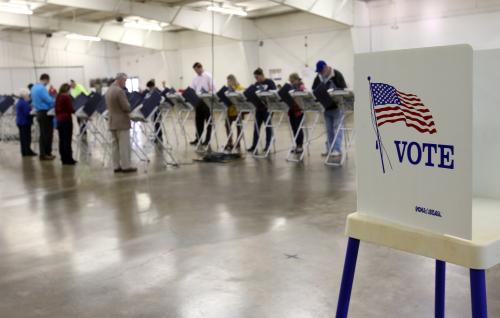Though it is still early on, President Trump sounds and acts the same as candidate Trump. His executive actions, side comments and tweets continue to gin up the divisive politics he stoked in campaign rallies and do nothing to diminish political divides that cut sharply across demographic lines—old versus young and white versus brown. Widening rather than closing this divide will endanger the nation now more than ever.
In July 2015, one month after he announced his bid for the presidency, The Washington Post published my essay “Stop Laughing at Donald Trump.” I wrote it as a warning to members of both the Republican and Democratic establishments, not to mention major media outlets, who were then ridiculing Trump as a less than serious candidate.
What they missed, and what I tried to point out, was the power of a campaign that played to the fears of older whites in a country that is undergoing swift demographic change and increased global connectivity. As I stated then:
Trump’s message is a call to 1950s American greatness and a simmering, mad-as-hell populism that blames Chinese imports, “freeloading” Saudis, and Mexican immigrants (and Mexico) for the nation’s ills. It appeals to a vein of the U.S. electorate that will remain a significant voting bloc for several election cycles to come: older whites.
Yet even I did not foresee how forcefully this populist message could play out in a rapidly diversifying country. Trump’s Republican primary wins and his general election Electoral College win were anchored by the support of whites age 45 and above. And while many of these voters were drawn to his promise of creating a better economy, a large part of Trump’s appeal was pitched to their fears of growing immigrant populations, racial minorities, political correctness, and other aspects of America’s emerging demographic change.
Now, just three weeks in office, the Trump administration has doubled down on his messages of fear with executive orders to build a wall along the Mexican border and impose an immediate ban of refugees, immigrants, and visitors from seven Muslim counties, not to mention the President’s unsubstantiated claim that he lost the popular vote as a result of 3 to 5 million noncitizens who illegally voted for his opponent.
While there is always room for a reasoned debate on immigration reform, refugee policy, and the like, these swift, highly symbolic actions from the President and his administration will continue to stoke the fears of his base that “the country is changing too quickly.” These messages clearly resonated in the election where exit polls showed that 85 percent of voters favoring building a wall were Trump’s mostly older white voters (compared with 10 percent who were Clinton voters); 83 percent of those favoring the deportation of illegal workers were Trump voters (compared with 14 percent who were Clinton voters).
Of course the fears among older whites about immigration and racial change are not just products of Trump’s candidacy. They build on a cultural generation gap revealed by national polling in recent years. Pew surveys as early as 2011 indicated that more than half of white baby boomers and seniors saw the growing numbers of newcomers from other lands as a threat to American values and customs. A 2015 PRRI poll shows that, more than younger generations, older whites think the country’s culture and values are worse today than in the 1950s.
These views reflect those of a generation that grew up during a period of low immigration in the 1950s and 1960s and have seen an explosion of diversity over the past 30 years. They remain fearful of what this may mean for their safety and for rising taxes, which may not go to families they see as their children.
The message they need to hear is that the growth and prosperity of minorities, especially younger minorities, is vital to their future. Due to the aging and retirement of the country’s white baby boom population, racial minorities will comprise all of the growth in the labor force population. As age dependency rises, the nation’s productivity and seniors’ well-being will be increasingly dependent on today’s youthful minorities.
Today, nearly half of young people under age 18 are racial minorities and a quarter are first and second generation immigrants. And this fraction will grow as the white population continues to age. Policies that invest in their future—their education, their health and their families’ well-being—will be essential for strong national growth. This will only occur if the older mostly white generation understands this and is willing to support the investment that this next multicultural generation needs.
Yet the messages of Trump’s campaign and early presidency are hardly conducive to making this happen. If this political demographic division continues, it will be counterproductive for the nation’s economic growth. And it will continue to be at odds with America’s long established history of welcoming and assimilating new populations.
Perhaps more importantly for the President’s party, the widening of this generational divide does not bode well for its future. Trump’s appeal to the “forgotten American” is reminiscent of Richard Nixon’s appeal to the “silent majority” of middle class whites who were shaken by the Civil Rights legislation and youthful protests of the 1960s. While Nixon and the Republicans were able to benefit from this strategy, the nation’s demography was quite different than it is today. In 1960, 13 percent of the U.S. population were racial minorities, mostly blacks living in highly segregated cities. When the 2020 census is taken, more than 40 percent of the population and 34 percent of eligible voters will be racial minorities of different hues, living in all parts of the country. Election simulations based on these future population statistics that assume the continuation of past voting patterns project Democratic wins in several presidential elections to come.
Trump’s presidency has just begun and has four years to make its mark. With the campaign behind him, it will benefit him, his party, and the nation to take steps to heal rather than aggravate the wounds of a political demographic division that are still very raw.
The Brookings Institution is committed to quality, independence, and impact.
We are supported by a diverse array of funders. In line with our values and policies, each Brookings publication represents the sole views of its author(s).







Commentary
Op-edTrump’s early actions will widen America’s political demographic divide
February 10, 2017